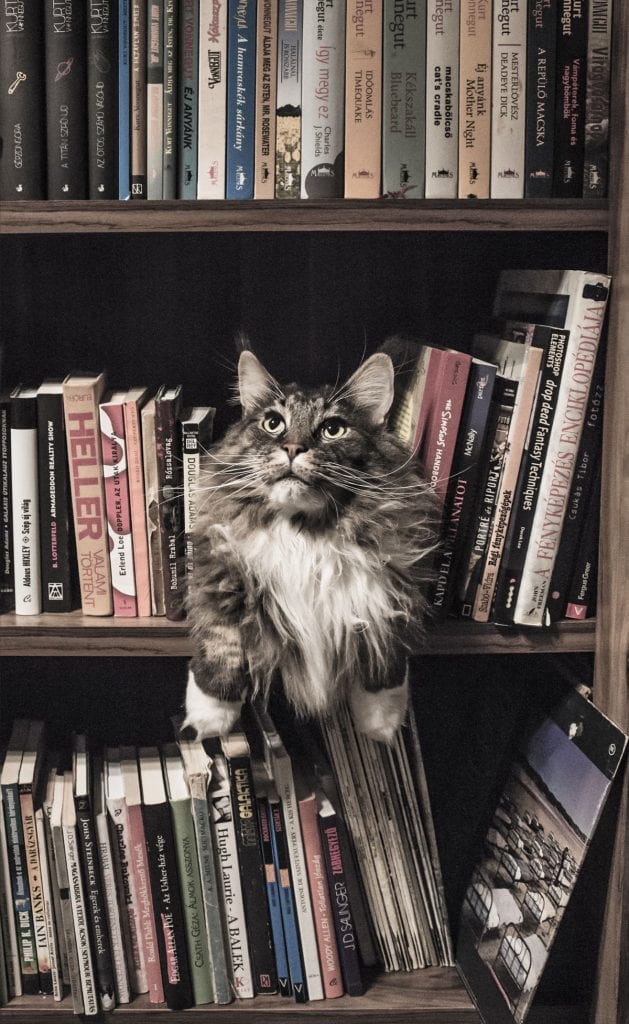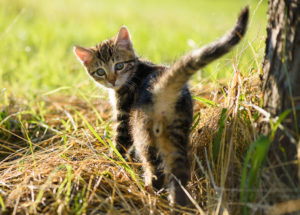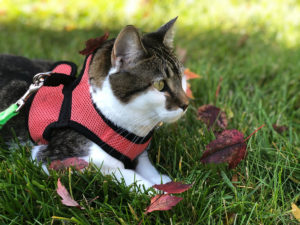No one likes to think about their cat going to the vet. You may even dread the thought. If your cat stays indoors, you probably imagine you’ve dodged a bullet. But indoor cats aren’t immune. They can end up swallowing pieces of string. And every cat risks long-term illness. So if the thought of potential vet bills has you hyperventilating, set the paper bag aside. Pet insurance for cats exists for that very purpose. Your faithful feline gets protection, and your wallet gets a breather.
Felines and Finance
We love our cats, and we’d do anything for them. They get automatic water fountains for constant supplies of clean, fresh water. We buy them the top electronic toys to stave off boredom. And if they doze on a favorite sweater (cashmere or not), the sweater becomes the cat’s possession.
But owning a cat can get expensive. Especially when our kitties decide to get injured or grow ill. A “simple” vet visit can quickly cut into a family budget. Charges vary depending on the clinic and your region, but these estimates provide a rough estimate:
- Limping: Exam Fee ($100) + Injectable Pain Medication ($50) + Radiographs ($180) + Oral Pain Medications ($60) = $390
- Vomiting: Exam Fee ($100) + Injectable Anti-Nausea Medication ($20) + Lab Work ($120) + Oral Medications ($60) = $300
- Urinary Obstruction: Exam Fee ($100) + Injectable Pain Medication ($50)…(Quite a bit fits here – it’s an emergency, after all)…Hospitalization = $1,500-$3,000 (if surgery’s required)
You can’t always prevent bad things from happening (though the water fountain’s an excellent start for urinary obstructions!). However, pet insurance for cats DOES make signing that estimate and paying the final bill easier on your wallet.
Pet Insurance for Cats
Pet insurance got its start when companies recognized the human-animal bond. As new advances in veterinary medicine continued to appear, policies improved to cover those treatments (or not). That insurance policy allows owners to focus on their pet and their needs, rather than the sudden hit their bank account’s about to take.
However, many people skip out on investing in pet insurance for cats. (Of course, people also believe cats don’t need the same level of veterinary care) And the excuses fall into a few common categories:
- “I have an indoor-only cat.”
- “Outdoor cats don’t need coverage.”
- “My cat’s an older senior.”
- “Kittens don’t need pet insurance.”
If any of these sound familiar, you’re in for a surprise. EVERY cat deserves pet insurance! Outdoor cats aren’t the only felines who benefit from the protection. In fact, I can provide three real-world examples as a demonstration.
Pet Insurance for Cats: Indoor-Only Cats
While Firefly was still a kitten, the company I worked for offered pet insurance for cats. The coverage wasn’t great (the start of the pet insurance boom didn’t provide a whole lot), and my budget was teeny-tiny, so I made the excuse that kittens didn’t need insurance. (Sound familiar?)
By six years old, he weighed a hefty sixteen pounds and served as a blood donor at the practice where I worked. Blood donors needed routine lab work annually, so I brought him in with me. I knew his weight was down a little, but I viewed it as a good thing. (He WAS a big boy) Then I looked at the blood tubes and felt my heart drop. Icteric (yellow) serum – a warning of a problem with his liver.
I panicked and showed the doctor on shift. We decided to run the lab work in-house instead of sending it to the outside lab. My indoor-only cat? Diabetic. Worse, he showed every sign of diabetic ketoacidosis (DKA). He spent the next TWO WEEKS in the hospital!
Lesson #1: Long-Term Illnesses
Overweight or obese cats tend to end up with diabetes mellitus. However, it’s not a given. (Firefly’s littermate outweighed him and NEVER turned diabetic) And diabetes (or other long-term illnesses) racks up costs FAST.
Your cat needs regular lab work. I check Firefly’s blood sugar at home (you CAN learn to do so), but that meant paying for the meter and buying the test strips. Otherwise, you go in for testing regularly. You also pay for insulin and syringes every couple of months. Depending on the type of insulin, the cost gets high. You might find coupons to help, but some pharmacies don’t honor them.
Guess where all of that money comes from? Your pocket. Guess what SAVES you? Pet insurance for cats.

Pet Insurance for Cats: Senior Cats
Cats live longer now. If you provide the best foods, nurture their mental health, and make sure they receive annual visits to the vet, your cat will see their senior years. Of course, senior cats tend to develop common health ailments.
I’d love to say I learned my lesson with Firefly and got him a pet insurance for cats policy after that diabetic episode. They wouldn’t cover the diabetes, but anything else? He’d be set. However, I figured six was ALMOST senior. Why would a senior cat need insurance?
Here’s why:
- Hyperthyroid: Senior cats often see their thyroid gland go haywire. The thyroid influences changes in the heart, kidneys – pretty much ANYWHERE. And treating it involves medication, regular lab work, and (possibly) I-131 treatment – when medication fails.
- Hypertension: Aging’s rough on the body. The kidneys can start to struggle (especially if the thyroid’s beating them up). The result is often an increase in blood pressure. You’ll need to intervene with medication, BP checks, and lab work.
- Eye Issues: Cats don’t succumb to glaucoma as frequently as dogs, but it IS possible. They can also decide to develop a sequestrum AND ulcer. This means frequent trips to the ophthalmologist, every eye drop on the planet, and a double keratectomy (removing part of the cornea in each eye).
Lesson #2: Aging Changes
You love your little old cat. But their body starts to undergo natural aging changes. Even when you’re doing everything right! And if you have a cat with long-term illnesses, those changes hit harder. There’s nothing you can do to prevent them. And you’re NOT to blame.
Pet insurance for cats helps you prepare for those anticipated complications. Many companies even cover the cost of treating cancer! If you’re ready to invest in your beloved feline for the long haul, take the financial concern out of the equation.
You know these changes lurk in the pipeline. And you CAN set aside money from each paycheck in anticipation, but what happens when something unexpected crops up? That policy eases your stress. Then you can watch your cat go into their sunset years without a worry.
Pet Insurance for Cats: Kittens
You think Firefly was my only kitten excuse, aren’t you? Nope! It turns out mistakes come in threes, same as good things. (By the way, my examples ARE mistakes, so you DON’T have to follow in my footsteps) Squeak rounded out my lessons on pet insurance for cats.
At two months old, the poor little guy had already been through the wringer. He came into the practice desperate for a blood transfusion, courtesy of a severe flea infestation. Then he battled a nasty Toxoplasmosis infection. With a minor case of cerebellar hypoplasia rounding out his record, I decided three strikes felt like plenty.
So when the doctor performing his neuter told me she heard a heart murmur, I thought nothing of it. Kittens CAN have murmurs, and he was JUST six-months-old. (Right on the cusp for a kitten murmur) It was the odd quiet night for us, though, so when she offered to pop him on the echo table, I agreed.
The little bugger had a patent foramen ovale (PFO): a hole connecting his two atria. And what I hoped was a kitten murmur? Genuine hypertrophic cardiomyopathy (HCM).
Lesson #3: Kitten Surprises
When you spot that kitten for the first time, you never imagine they might have something sinister lurking inside. And they may not. But is that a risk you’re willing to take? Because ZERO pet insurance companies cover pre-existing conditions.
None of Squeak’s troubles in the first weeks of his life caused his cardiac issues. He’s one of those cats with a bum ticker. Now he gets an echocardiogram every 6-9 months and daily medication. And if I thought about pet insurance for cats in the months before his neuter, all of it? Covered – 100%.

How Pet Insurance for Cats Works
Pet insurance for cats is a bit of a gamble. You pay money each month, HOPING you won’t need it. Meanwhile, the company offers to cover a percentage of your vet bills (HOPING they won’t need to). No two insurance companies work the same, which means looking at your cat’s age, current health, lifestyle, and YOUR budget. It also helps to understand some of the terminologies you’ll come across when you start shopping around.
Premiums
A pet insurance premium is a physical amount you pay each month. It’s compounded of three different parts (typically):
- Deductible: This is the amount out-of-pocket you’re responsible for. You usually have the option of choosing this price.
- Coverage: Many pet insurance for cat companies allow you to choose the percent coverage (others have a fixed percentage). You decide what to set the coverage at.
- Your Cat: Companies calculate a price based on the region where you live, your cat’s age, whether they’re spayed/neutered, and their breed.
You get a little control over that premium, so look at your budget carefully. Are you more concerned with a low monthly payment or maximum coverage? (You can’t do much with your cat’s info)
Caps
A cap is a maximum amount the insurance company will pay. Some pet insurance for cats works by the incident, some by year. Consider your cat’s situation. Which works best? You can also find insurance companies with NO caps. After you mee the deductible, they’ll pay throughout the life of your cat! Of course, this may mean a higher premium, but if you know you have a breed with a risk for HCM or another long-term illness, isn’t that worth it?
Bonuses
You’re looking for pet insurance for cats to prevent bankruptcy. That doesn’t mean you can’t look for some nifty extras with your policy. Plenty of companies offer bonuses unrelated to your cat’s health to entice you. These include:
- Boarding fees
- Help with advertising if your cat goes missing
- Discounts if you apply with multiple pets (Note: you don’t have to stick to just cats!)
- Coverage if you have to cancel vacation plans
- Particular policies for rehab and alternative medicine
Save the Cat AND the Wallet
You don’t want to consider needing pet insurance for cats. It’s kind of grim. (Believe me, I understand) After cringing vet visit after vet visit and saying “Should have” about a hundred times, when Tonks entered the household? Yeah, she got pet insurance within a week of her spay date. (It was cheaper that way) Has she needed it yet? No. Do we breathe a sigh of relief every day, knowing it’s there? Yes – especially when she walks across the curtain rods.
Having pet insurance beats NOT having it.













No comment yet, add your voice below!